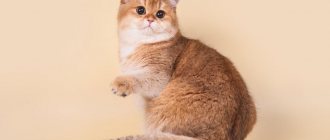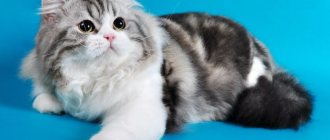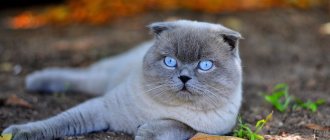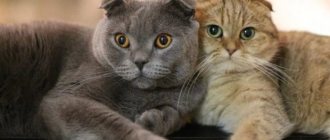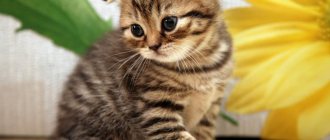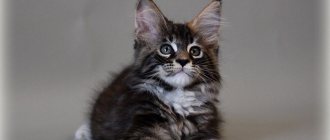11550Administration
Few people know that caring for a Scottish Straight kitten is slightly different from caring for a Scottish Fold kitten. Features of care include not only increased attention to health and care, but also to nurturing the character of the Scottish cat, developing the right habits and adapting the kitten to the family.
The main points to pay attention to are:
- litter box training;
- having your own place and organizing a place for play, scratching posts;
- establishing a feeding system;
- eye care;
- proper wool hygiene;
- timely bathing and ear hygiene;
- trimming nails and cleaning teeth;
- timely visit to the veterinarian.
If you follow all the rules of care, which will be discussed below, your Scottish cat will always remain healthy and active, and preventive examinations by a veterinarian will not take a lot of time and cause you trouble.
© shutterstock
Tray training a kitten
Toilet training a Scottish cat requires especially a lot of patience from new owners if the kitten has not been accustomed by the breeders to a specific litter and taught the basic rules of personal hygiene. Caring for a Scottish cat will necessarily include timely replacement of the litter, since Scottish cats are very clean and may completely refuse to visit the litter box if it is not cleaned on time and proper care is provided.
If your kitten goes to the toilet in the wrong place, you should not scold him, since the character of the Scottish cat is quite stubborn and she will regard this not as a lesson and basic care, but as direct aggression.
Proper care will include the gentle upbringing of a Scottish cat, in which case the cat will grow up docile and will not shit in inappropriate places, either intentionally or accidentally.
Organizing your own place
Comprehensive care for a Scottish cat includes organizing your own place for the kitten and preparing special toys. These include not only a scratching post, but also many small toys in the form of mice, balls, and various fishing rods, which not only develop the Scottish cat, but also allow you to protect your personal belongings from the kitten’s harm.
The representatives of this breed themselves, Scottish cats, are quite well-mannered and will not play with the personal belongings of their owners, but still a large number of toys will only please your pet. A prerequisite will be the purchase of a house or bed , which will become its own personal space for your Scottish cat.
© shutterstock
Place and utensils for feeding
The Scots are quite calm and delicate by nature, so it is better for them to set up a place to eat in a quiet and secluded place.
- Volume . It is recommended to feed such babies from not too deep, but wide bowls made of materials such as clay, ceramics or high-quality plastic.
- Material of manufacture . It is important that the bowls do not make noise or cause stress to the kitten when eating. It is not recommended to use metal or aluminum utensils that can release dangerous chemical compounds when the temperature increases.
- For water. A deeper container with water is placed separately. A straight-eared Scottish kitten should have free access to clean water around the clock.
Manicure
Purchasing a scratching post is also a maintenance requirement, as cleaning nails is a natural need for any cat, and Scottish cats are clean enough to sharpen their claws on your furniture. It is best to organize the Scottish cat’s space in such a way that all the toys, scratching post and her personal house are within visual reach, then she will understand that this is her territory and will not disturb you if you want to be alone.
It is very important to refresh your Scottish cat's environment from time to time, since most cats spend their entire lives in confined spaces and variety in toys and games will certainly please your kitten.
Nutritional Features
The diet of Scottish straight-eared kittens is no different from the diet of fold-eared representatives of this breed. The structure of nutrition depends on what kind of food you prefer to feed it - natural or dry. From two to three months you can completely switch the kitten to artificial nutrition, but for some time it is recommended to give him milk in small quantities and low fat content.
Mandatory components of care and natural nutrition should be:
- fish and dietary meat;
- milk products;
- various types of cereals;
- cooked or raw vegetables, depending on your pet’s preferences.
© shutterstock
It is worth noting that when choosing meat and fish, you should be guided by the following rules:
- products must be well cooked and thoroughly chopped;
- It is recommended to include porridge in every meal and mix it with meat products;
- by-products are allowed only in small quantities and if thoroughly cleaned;
- greens and seasonings are completely excluded;
- You can combine dry or wet food with natural food in equal proportions throughout the day.
Natural food for Scottish Straight kittens
Let's talk about natural food, which is preferred by most owners. So, what can you give a Scottish kitten?
- Meat for a kitten, as for an adult, is extremely important. Breeders insist that meat should be present in the diet every day. But, of course, it must undergo pre-treatment, that is, be boiled or at least scalded. If the owner prefers freezing, then he should freeze the meat for at least 3-5 days. Dosage – approximately 30-40 g at a time. The pieces, of course, must be thoroughly chopped. As mentioned earlier, the product should be low-fat, that is, beef, turkey, and chicken are perfect.
- Suitable by-products are beef or chicken - heart, lungs, liver, kidneys. The liver is especially useful, containing a lot of microelements and vitamins. However, breeders emphasize that, despite all the benefits of this product, it should not be given more than once a week. Otherwise, problems with the baby’s stomach cannot be avoided.
- But you need to be careful with fish. It is both true and a myth that kittens benefit from feeding this type of food. Yes, it is a protein, but it is absorbed quickly, which can lead to kidney problems. Ideally, you can treat your pet to this food about once a week. Low-fat varieties are needed - hake, carp, perch. And, of course, it is important for kids to boil the fish first.
- Dairy products also fall into the category of myths. Yes, milk is generally healthy, but it can only be given to kittens up to 3 months old. Which many people, unfortunately, don’t know about. If the owner feeds the baby himself, then until the specified age he can still give boiled milk, but later he should be weaned off milk. Otherwise, intestinal upset becomes a frequent companion of Scottish cats. The way out of the situation is to treat your pets with sour cream, kefir, and cottage cheese. It is preferable that the products contain a small percentage of fat. You can choose cottage cheese and kefir that are often fed to human children. By the way, a pregnant cat should also consume similar cottage cheese.
- Vegetables are very useful for babies. Except for potatoes. Three times a week you can grate raw vegetables on a fine grater or puree boiled ones. Pumpkin is especially useful - it is a good remedy for worms.
- From porridges you should choose oatmeal or buckwheat. You can cook them in both milk and water. And together with meat broth and vegetables, you get a great dish!
What to pay attention to
It is worth carefully monitoring not only the diet, but also the number of servings, since feeding Scottish Straight cats requires a clear dosage . This is due to the fact that this breed is prone to obesity and a Scottish cat cannot always control its appetite, when it is not really full, and when it has overeaten. However, if a Scottish cat leaves food on the plate, you should not immediately contact a veterinarian, because you can adjust the portion size based on the mood and activity of the Scottish cat.
The Scottish Straight kitten should be fed in such a way that 40% of all food is protein.
Up to a year, it is recommended to structure the diet in such a way that it is divided into three to four meals, and for adult cats, 2 feedings during the day will be optimal. A prerequisite must be the availability of clean, boiled water.
Adult pet diet
The structure of the digestive system of all cats is not particularly different, therefore, for an adult cat from the Scottish Fold and Straight-eared species, the food does not differ in composition. The main thing is to provide your pet with a varied, high-quality and balanced diet.
Table No3. Diet of an adult Scottish Fold or Straight-eared cat.
We invite you to familiarize yourself with Feeding cattle: diet and norms, types of feed
Ready-made food from manufacturers of dry and wet products has the following advantages:
- Convenient for feeding, it is produced in production in the form of mixtures: - pastes, pieces of jelly, canned food and dry pads. Doesn't take much time to cook.
- The composition fully takes into account the cat’s need for a complex of beneficial substances for the body with the addition of vitamins, minerals, and herbal ingredients.
- For each type of product, a dosage of the daily amount required for a balanced diet has been developed.
- The mixtures include natural products processed using a special technology that ensures long-term storage.
Food is produced in different categories: holistic, super-premium, premium, economy class, consistent with the age of the kitten.
The finished food is easily digested by the animal’s body and is eaten with pleasure.
When switching Scottish cats to ready-made food, you must adhere to the following feeding rules:
- Choose only high-quality food for feeding Scottish fold and straight-eared purebred cats: holistic, superpremium, premium class.
- Strictly follow the manufacturer's recommended daily or single dosage of the product indicated on the packaging.
- You can feed your pet in two modes:
- One-time, once a day, the entire amount of food is laid out in a bowl. So, it’s convenient to feed your pet for busy owners.
- Portioned, the entire daily dose is divided into shares and given to cats according to a time schedule. More useful for the cat, there is no threat of obesity.
- The animal is constantly provided with free access to water. Use bottled liquid and replace it with fresh one daily.
Recommended food from finished product manufacturers for Scots: Royal Canin, Hill's Science Plan, FLATAZOR CROCKTAIL, Sanabelle.
Table No. 4. Popular companies producing cat food.
Natural nutrition
There is no doubt about whether it is worth feeding a Scottish kitten regular food and what food is best for kittens. Tasty, fresh food, natural in composition, close to the natural nutrition of animals. Properly selected food prepared from a variety of products will please your baby. When eating natural foods, vitamin complexes are additionally included in food.
For the owner, daily cooking creates certain difficulties and requires a lot of time. Many people cut up a large complex amount of food in advance, including meat products, vegetables, eggs, herbs, for a week. The entire prepared mass is laid out in portions into bags and frozen. Use daily, giving to the pet after heating.
There are two power modes:
- Constant, when the daily amount of food is immediately placed in a large bowl. And the pet eats everything as desired. This regime is convenient for busy owners, but there is a risk of cat obesity.
- Portioned, when food is given out in small quantities several times a day, the cat gets used to not overeating, which is good for his health. This makes feeding convenient for those who are constantly at home and can maintain an hourly schedule.
Prohibitions
There are foods that are strictly not allowed for feeding cats:
- potatoes and any dishes made from them;
- greens and grass grown on the windowsill or purchased in special stores;
- pasta and food with spices and herbs;
- fatty meats such as pork;
- dairy products with a high percentage of fat content.
Taking into account the structural features of bone and cartilage tissue, it is necessary to regulate your pet’s nutrition in such a way that it receives all the necessary nutrients, especially in the period up to 1 year, so the nutrition of a straight-eared British kitten is of great importance in the process of care, and its regulation ensures the health and longevity of your cat.
© shutterstock
Diet for a pregnant Scottish cat
Feeding a pregnant cat requires special attention to an enhanced diet and more frequent feeding. Not only the female is provided with food, but also the emerging babies in her womb.
Feed, both industrial and natural in composition, should contain not only healthy products: meat, fish, vegetables, cereals, fermented milk, but also a complex of vitamins, minerals, protein, and microelements. For the formation of embryos, the mother needs taurine, fatty amino acids, calcium phosphorus and other elements. Ready-made food for Scottish cats should be holistic or super premium, which has a specialization for pregnant cats.
What to feed a pregnant Scottish Fold and Straight-eared cat is determined by the period of its condition. It is conditionally divided into 3 stages:
- The first three months (trimester) of pregnancy are not externally detectable, but the Scottish cat's appetite increases. The diet remains the same, the volume of food increases by 30 grams. It is important not to overfeed a pregnant cat. The frequency of meals is gradually increased to 5 times a day in small portions.
- During the second trimester, embryos actively grow, the volume of food gradually increases to 2 times
- During the third trimester, your cat's appetite may decrease significantly. The embryos have already gained normal weight and body shape; they do not require increased nutrition. During this period, there is no need to force feed the Scottish cat; she regulates her own needs and instinctively prepares for childbirth.
We invite you to familiarize yourself with White broad-breasted turkeys: care and feeding rules
How to feed a Scottish Fold cat after giving birth depends on her condition and the number of kittens in the litter. The animal becomes weak in the process of bearing and giving birth to babies; it needs increased high-calorie nutrition to restore and produce milk. But for the first few hours after lambing, the cat refuses to eat, which is natural for her condition. You need to monitor your pet’s well-being and offer to drink water or heated milk diluted with kefir.
The amount of food depends on the number of kittens born, the age of the cat itself and the type of food it previously received.
When feeding industrial products, the manufacturer remains the same, but premium food is selected, specially designed for the postpartum period of cats. They are supplemented with nutritional supplements that stimulate lactation to ensure adequate nutrition for babies. For Scottish fold and straight-eared cats, Royal Canin products are suitable, dry food with a high vitamin and protein content. The first days after birth, dry food is soaked in low-fat broth or milk.
When feeding a Scottish cat with natural products before pregnancy, the diet is not changed, but foods that increase lactation, such as milk, and more often kefir and cottage cheese, are added. During the first few days, the meat is ground into a blender and diluted with broth. The menu must include vegetables, fish, and herbs.
Eye care
A mandatory procedure for caring for the eyes of a British kitten is to examine them and wipe them with a special swab, which must first be moistened in water or a special liquid.
Such simple procedures will help eliminate infection and eye diseases that are typical for representatives of this breed. You need to clean the eye by wiping it from the outer corner and towards the nose.
In this case, it is necessary to avoid strong pressure. A peculiarity of Scottish cats is that their eyes are very watery due to the fact that they have a narrowed shape, so it is necessary to regularly clean the tear ducts. Under no circumstances should you allow non-transparent tears to appear , as this is the main sign of eye infection. In this case, you should definitely contact a veterinarian and follow all his recommendations in order to ensure a quick recovery.
Special ready-made food: what to prefer
The most important rule in this case is that the food must be “premium class”. Even if such food is more expensive, it will definitely not cause harm and will be beneficial
As for the consistency, breeders especially like to feed their little charges mousse - it is most convenient to eat.
Food for babies must be designed for their age, since pellets for adult animals are larger and, as a result, inconvenient
As for brands, you should pay attention to the following:
- “Hills” - contains phosphorus, magnesium, calcium in excellent balance. It has a medicinal line of foods available, but you should first consult with a veterinarian about the advisability of using them.
- "Royal Canin" - contains enough fiber and an acceptable dosage of quickly digestible proteins. Helps create an optimal balance of intestinal flora and normalize the animal's stool.
- “Innova EVO” is favored by experienced breeders due to its composition of fresh meat and vegetables, oils, minerals, and vitamins. Fats and oils have a good effect on the immunity of kittens, and the absence of harmful impurities and even taste and smell enhancers guarantees high quality food.
- “Matisse” - most of the composition is chicken meat and fat, rice, fish, eggs. In addition, the food contains a whole complex of vitamins and calcium.
Scottish is a breed that attracts with its beauty and dignity
However, for all this, just a good pedigree is not enough - care is also of no small importance. But there is nothing complicated about the issue of proper feeding if you figure it out in advance and don’t improvise on the fly
Wool and its care
To care for the fur, special combs and brushes are used, which must be used to comb the cat regularly. This procedure is required due to the fact that the fur of Scottish kittens and adult cats is quite matted, and the cat cannot always clean it completely on its own. This procedure is mandatory for both short-haired and long-haired representatives of this breed. With regular brushing, the cat will shed less and its coat will look much more beautiful. There are several types of brushes:
- with a wide comb and fine teeth;
- natural and artificial;
- basic and decorative.
As additional care for the coat, you can use special lotions that make the coat easier to comb and make it more well-groomed. If your cat has peeling skin, you definitely need to choose special products that will help eliminate it, as this indicates general skin diseases.
© shutterstock
How to care
Any owner of a straight-eared Scottish cat should not forget that they need not only food and care for good immunity, but also affection with tenderness. In this regard, it is so important to purchase such a baby only if you can give him a lot of attention every day.
However, taking care of these cats is not at all difficult, nor does it require spending a lot of time and money.
Initially, you should figure out what kind of food Scottish Straight babies need, since food largely determines the pet’s immunity and life expectancy. When caring for a kitten, you should follow the main points listed below and strive to maintain the temperature in the house at 19-23°C. Watch how to care for a kitten.
Scottish Straight cats are very clean dogs, so the owner can only brush them a couple of times a week and sometimes wash them. This breed has a short coat, but it is necessary to take care of it. It is good for the baby to get used to the process of combing at a very young age; it is more difficult to accustom an adult.
You should know that high-quality fur care can only be achieved with the use of special shampoos and at least a couple of combs.
Bathing
Features of caring for a straight-eared kitten include mandatory water procedures, which involve getting used to swimming in warm water.
Such bathing allows not only to prevent the appearance of hairballs in the stomach, but also allows you to make the cat more well-groomed, prevent the appearance of dandruff and fleas, and also prepare it before an exhibition or festival. You need to accustom your kitten to bathing as early as possible so that he is not afraid of water and water procedures do not become stressful for him.
